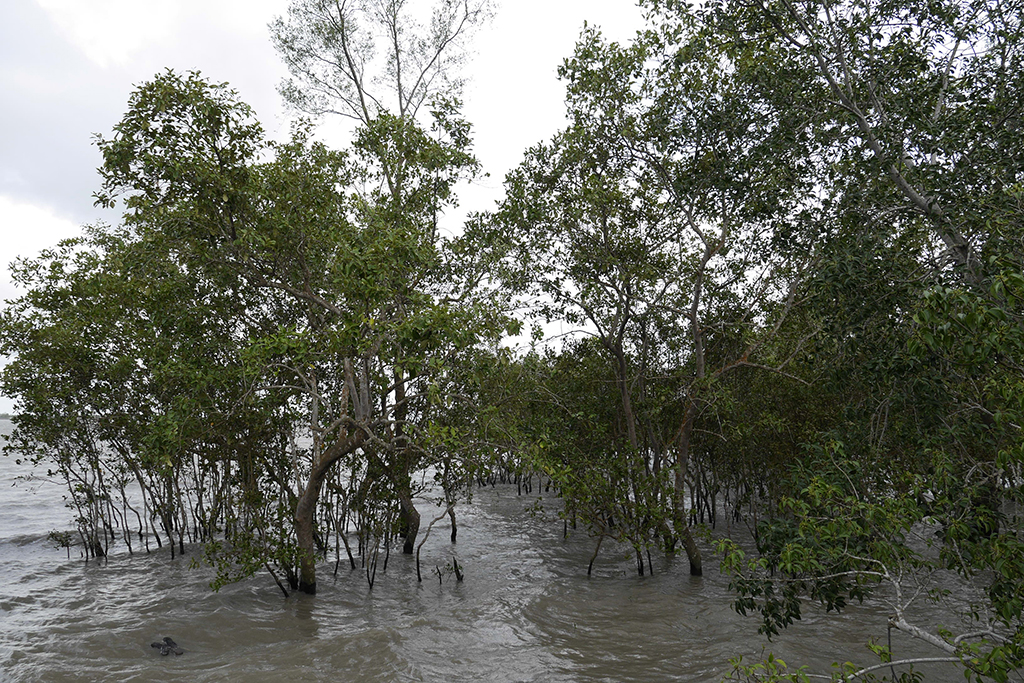Khulna Range of Sundarbans and associated areas
The Sundarbans Reserved Forest covers in total 600,386 ha – the world’s largest mangrove forest – and extends across three districts and four administrative ranges of the Forest Department. From west to east four CMCs work to protect the Sundarbans – Munshigonj, Dacope-Koyra, Chandpai and Sarankhola, as well as the Ecologically Critical Area that surrounds the forest as a buffer. Khulna range covers 170,610 ha. Within Khulna range is Sundarban South Wildlife Sanctuary designated in 1996 to protect 36,970 ha of mangrove forest.
This forest is adapted to brackish tidal waters and forms a natural barrier between the Bay of Bengal and mainland Bangladesh. The forest traps sediment, naturally building land and helps protect coastal people from high tides, storms and cyclones. However, storms and climate change pose threats to the forest, and increasing intrusion of saline water north of the mangroves during the dry season hampers agriculture and access to fresh water for our communities. Illegal felling of trees, and poaching of Tiger and Spotted Deer are significant challenges. In addition to being home to one of the world’s largest populations of Tigers, the sanctuary of this range protects important populations of two nationally rare reptile species – the Estuarine Crocodile and the Asiatic (Indian) Rock Python.
Khulna range is bordered to the north by 78 villages where most of the people depend directly on the mangrove ecosystem. Collection of shrimp larvae, fish and golpata (Nipa fruticans) palm leaves are the main income sources. However, destructive practices used in catching prawn and shrimp post larvae and excess pressure catching finfish and crabs threaten the ecology of the area and sustainability of livelihoods.
WHY ARE SUNDARBANS MANGROVE FORESTS IMPORTANT?
A Ramsar and World Heritage site
The largest block of mangrove forest in the world
Home to globally endangered Royal Bengal Tiger, Ganges River Dolphin and Masked Finfoot
High species diversity: 120 fish species, 8 amphibian species, 50 reptile species, 42 mammals, over 250 bird species, and 60 shrimp species
Stores over 250 tons of carbon (equivalent to 939 tons CO2 per hectares)
Local people are poor and depend on forest resources, threatening the biodiversity and ecology
CO-MANAGEMENT HELPS PROTECT CRITICAL FOREST HABITATS IMPORTANT FOR A WIDE RANGE OF CREATURES AND PLANTS, INCLUDING GLOBALLY THREATENED SPECIES …

Tiger (Panthera tigris)
Please support this important work
The largest cat and our national animal, the magnificent Bengal Tiger has disappeared from the rest of Bangladesh and is globally endangered. The Sundarbans are home to one of the largest remaining populations. A solitary predator that readily swims, and is an expert at remaining hidden, it hunts mainly Spotted Deer and Wild Boar. The Forest Department and communities are working together to protect tigers and their habitat
Please support this important work
The largest reptile in Bangladesh and only crocodile species with a remaining viable population. It may appear docile when resting and warming itself on the riverbanks on cold mornings, but it can swim and run quickly to catch fish and animals. It is an important indicator of a healthy aquatic ecosystem. The Sundarbans, especially the sanctuaries, are the only area where it occurs in Bangladesh.

Estuarine Crocodile (Crocodylus porosus)
Sustaining Nature, Biodiversity, and Local Communities
Dacope-Koyra Co-Management Committee engages with local communities to conserve the west central part of Sundarban and adjacent area, and its threatened species, through climate-resilient natural resources management and diversified livelihoods
Co-Management in Khulna range was established through Dacope-Koyra CMC established in November 2011 and is recognized through a Ministry of Environment and Forests order published in November 2009. Dacope-Koyra CMC formally works with and includes Bangladesh Forest Department as well as all key local stakeholders including local government and of course representatives of the surrounding 78 villages who are organized into a common forum. We help protect the Sundarbans under an integrated resource management plan, and promote sustainable practices in over 15,600 ha of the Sundarbans Ecologically Critical Area in coordination with Department of Environment. Dacope Koyra CMC is working with others to promote sustainable fisheries and conserve Tigers and other threatened species.
DACOPE-KOYRA CO-MANAGEMENT COMMITTEE (CMC)
KEY OBJECTIVES:
- Conservation of biodiversity in Sundarban forests and its Ecologically Critical Area
- Mobilize local people including youth as environmental stewards and stakeholders
- Assist natural resource users to enhance and diversify their livelihoods, reduce extraction from forests, and reduce vulnerability to hazards and climate change
- Encourage eco-tourism, and provide adequate facilities for visitors
- Provide a forum for discussions,consultations, and conflict resolution
How You Can Help ?
Please support our efforts to strengthen conservation. The work of Dacope-Koyra CMC and associated organizations involves local communities working with local government and Bangladesh Forest Department. These activities depend on support from grants and outside resources.
Dacope-Koyra CMC has a bank account and can receive grants from domestic sources. For international assistance, funds can be channeled through CNRS – a national NGO which has helped establish the CMC. CNRS is registered with Bangladesh NGO Affairs Bureau, registration no. 841. Its programs focus on Natural Resource Management.
Your donations to Dacope-Koyra CMC will support:
- Improving protection of forest, and their threatened species, through community patrols and forest restoration
- Creating awareness among the local people and increasing alternative income source.
- Reducing conflicts between people and animals, especially Tiger (e.g., relocating cultivation, patrols, education,, improving warnings, and a compensation fund)
- Promoting eco-tourism (e.g. establishing and maintaining visitor facilities and publicizing the Sundarbans)
- Increasing community sustainability (e.g. reducing disaster vulnerability and improving services)
Contacts
President
Dacope-Koyra CMC
Kashiabad, Koyra, Khulna
Tel: + 01718 873 858
Forest Department
DFO, Sundarban West Forest Division
Tel: 041 720665
Member Secretary
Dacope-Koyra CMC
Kashiabad, Koyra, Khulna
Tel: + 01718 029 589
CNRS
M. Mokhlesur Rahman
Executive Director
Floor 4-6, House 13, Road 17, Block D, Banani, Dhaka 1213
Tel: 01711 549 460;
Email: mokhles_cnrs@yahoo.com





Leave a Reply